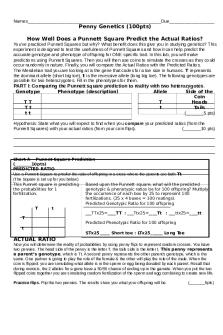Chicken Genetics Gizmo PDF

| Title | Chicken Genetics Gizmo |
|---|---|
| Author | Harlie Dupler |
| Course | Biology |
| Institution | North Central College |
| Pages | 4 |
| File Size | 251.9 KB |
| File Type | |
| Total Downloads | 15 |
| Total Views | 181 |
Summary
both the red and the white alleles show up in the heterozygous flower, the red and white alleles are most likely codominant to each other....
Description
Name:
Harlie Dupler
Date:
Student Exploration: Chicken Genetics Directions: Follow the instructions to go through the simulation. Respond to the questions and prompts in the orange boxes. Vocabulary: allele, codominance, dominant, genotype, heterozygous, homozygous, phenotype, probability, Punnett square, recessive, trial Prior Knowledge Questions (Do these BEFORE using the Gizmo.) 1. The image shows a flower that was produced by crossing a pure red flower with a pure white flower. Which do you think is the dominant petal color: red or white? Explain.
2. How is the inheritance pattern shown by this flower different from other inheritance patterns you have seen or studied?
Gizmo Warm-up There are many different ways traits can be inherited. Some traits are governed by alleles that are dominant over other alleles. Other traits are governed by alleles that share dominance. These alleles follow a pattern of inheritance called codominance. With the Chicken Genetics Gizmo, you will study how codominance affects the inheritance of certain traits. 1. Turn on Show genotype. The genotype is the allele combination an organism has. Point to the red chicken. A. What is the red chicken’s genotype? B. What is the white chicken’s genotype? 2. What do you think the letters F, R, and W stand for in the genotypes?
Reproduction for educational use only. Public sharing or posting prohibited. © 2020 ExploreLearning™ All rights reserved
Activity A: Codominant traits
Get the Gizmo ready: ● Drag a red chicken and a white chicken into the parent boxes, but don’t click Breed yet.
Question: What inheritance patterns do codominant traits display? 1. Predict: What do you think the offspring of a red chicken and a white chicken will look like?
2. Observe: Click Breed. What are the offspring genotypes? An organism’s appearance is its phenotype. Describe the offspring’s phenotype.
3. Experiment: Drag four offspring to the Holding Cages. Click Clear, and then drag one of the offspring to a parent box. Drag a white chicken to the other box. Click Breed several times. Describe the resulting genotypes and phenotypes of the offspring.
4. Revise and Repeat: Click Clear. Drag another chicken from the Holding Cages to the parent box. Drag a red chicken to the other box. Click Breed several times. Describe the resulting genotypes and phenotypes of the offspring.
5. Explain: In dominant/recessive inheritance patterns, the dominant allele is always expressed when present. The recessive allele is only expressed when the dominant allele is not present. Use your observations from this activity to describe how codominant inheritance patterns differ from dominant/recessive inheritance patterns.
Reproduction for educational use only. Public sharing or posting prohibited. © 2020 ExploreLearning™ All rights reserved
Activity B: Codominant crosses
Get the Gizmo ready: ● Click Clear. ● Drag the remaining chickens from the Holding Cages into the parent boxes.
Introduction: Probability is the likelihood that a specific event will occur. Scientists use probability to predict the outcomes of different genetic crosses. Question: How can you use probability to predict the outcome of a codominant cross? 1. Model: A Punnett square is used to model the possible offspring genotypes from a genetic cross. The parent genotypes are written at the top and side of the square, as shown. The possible offspring genotypes are then filled in. The first square is filled in for you. Fill in the remaining squares. (Note FRFW is equivalent to FWFR.)
FR FR
FW
FR FR
FW
2. Analyze: A homozygous chicken will have the same alleles for feather color. A heterozygous chicken will have two different alleles for feather color. A. Are the parents homozygous or heterozygous? Explain how you know.
B. What are the possible genotypes of the offspring? C. Will the offspring be homozygous or heterozygous? 3. Calculate: Punnett squares can be used to predict probable outcomes of genetic crosses. To calculate probability, divide the number of one kind of possible outcome by the total number of all possible outcomes. For example, if you toss a coin, the chance it will land on heads is equal to 1 ÷ 2. This probability can be expressed as ½, 0.5, or 50%. Look at the Punnett square above. A. How many total possible outcomes are there? B. How many of the possible outcomes are there for each of the following genotypes? FR FR
FW FW
FR FW
C. What is the probability for each of the following outcomes? (Record answers as both fractions Reproduction for educational use only. Public sharing or posting prohibited. © 2020 ExploreLearning™ All rights reserved
and percentages.) FR FR
FW FW
FR FW
4. Test: Use the Gizmo to test your predicted outcomes. Turn on Show statistics and Show as approximate percentage. Click Breed. What are the results of the cross?
5. Evaluate: Did the results of the cross match your prediction? If not, why do you think that was the case?
6. Collect data: Click Breed 19 more times until you have generated 100 offspring. How do the percentages match your prediction now? Have they gotten to be more or less similar to your original prediction?
7. Compare: Click Breed until you have generated at least 1,000 offspring. Compare the statistics on the Gizmo with your original predictions. How close are they?
8. Draw conclusions: Each time you bred the parent chickens, you completed a trial. A trial is a single time that you conduct an experiment. Random chance often causes identical trials to have different outcomes. Because of this, scientists repeat experiments many times in order to make sure that chance alone is not responsible for the results of a trial. How did your results change as the number of trials you completed increased? Why was it important for you to breed the chickens repeatedly in this experiment?
Reproduction for educational use only. Public sharing or posting prohibited. © 2020 ExploreLearning™ All rights reserved...
Similar Free PDFs

Chicken Genetics Gizmo
- 4 Pages

Chicken Genetics Gizmo
- 5 Pages

Caso Kentucky F Chicken
- 10 Pages

Master Poached Chicken
- 1 Pages

Genetics Penny Genetics
- 4 Pages

Chicken-soup for soul
- 65 Pages

SWOT - Texas Chicken (Final)
- 16 Pages

Butter Chicken Factory
- 9 Pages

Franquicia Kentucky Fried Chicken
- 117 Pages

Chicken Macaroni Salad Recipe
- 2 Pages

Chicken wing label experiment
- 2 Pages
Popular Institutions
- Tinajero National High School - Annex
- Politeknik Caltex Riau
- Yokohama City University
- SGT University
- University of Al-Qadisiyah
- Divine Word College of Vigan
- Techniek College Rotterdam
- Universidade de Santiago
- Universiti Teknologi MARA Cawangan Johor Kampus Pasir Gudang
- Poltekkes Kemenkes Yogyakarta
- Baguio City National High School
- Colegio san marcos
- preparatoria uno
- Centro de Bachillerato Tecnológico Industrial y de Servicios No. 107
- Dalian Maritime University
- Quang Trung Secondary School
- Colegio Tecnológico en Informática
- Corporación Regional de Educación Superior
- Grupo CEDVA
- Dar Al Uloom University
- Centro de Estudios Preuniversitarios de la Universidad Nacional de Ingeniería
- 上智大学
- Aakash International School, Nuna Majara
- San Felipe Neri Catholic School
- Kang Chiao International School - New Taipei City
- Misamis Occidental National High School
- Institución Educativa Escuela Normal Juan Ladrilleros
- Kolehiyo ng Pantukan
- Batanes State College
- Instituto Continental
- Sekolah Menengah Kejuruan Kesehatan Kaltara (Tarakan)
- Colegio de La Inmaculada Concepcion - Cebu




